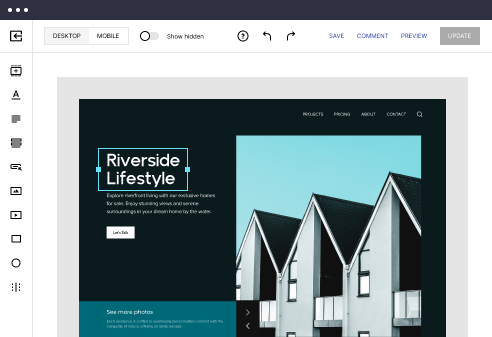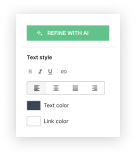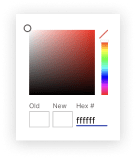
HTML/CSS optimized conversion focused page template
Explore Similar TemplatesAbout template
Supercharge your conversion focused page with HTML/CSS for outstanding performance! Learn more today.
Recommended templates
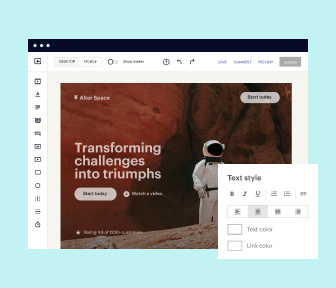
Easy to build without coding
With the intuitive drag-and-drop builder, anyone on your team can create high-converting pages without any knowledge of code or design. Make enhancements to your landing page with custom widgets using Javascript, HTML/CSS, or third-party scripts.
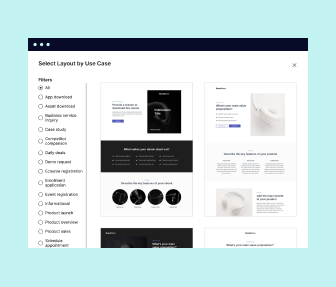
Multiple layouts for any industry and goal
Select from 500+ landing page layouts built to boost conversions across industry-specific scenarios. Customize them by adjusting fonts, adding images, and generating on-brand content with the AI assistant. Quickly scale with Instablocks® and Global Blocks that you can save, reuse, and update globally.
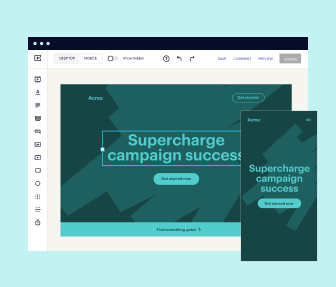
Loads fast and looks polished on any device
Every template is responsive, which means they present professionally on any device and load blazingly fast with our Thor Render Engine. You can also power them up with Google AMP technology to deliver an unparalleled mobile experience and drive higher conversions.
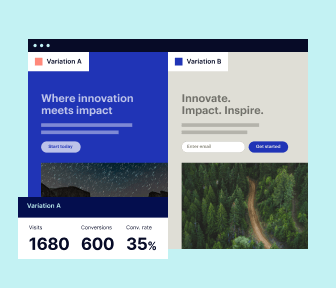
Robust analytics & experimentation
Get real-time updates and reporting across all your devices, showing the number of visitors, conversions, cost-per-visitor, and cost-per-lead. Launch AI-powered experiments, run A/B tests, and use heatmaps to analyze user behavior, then optimize your landing page to maximize conversions.

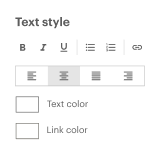
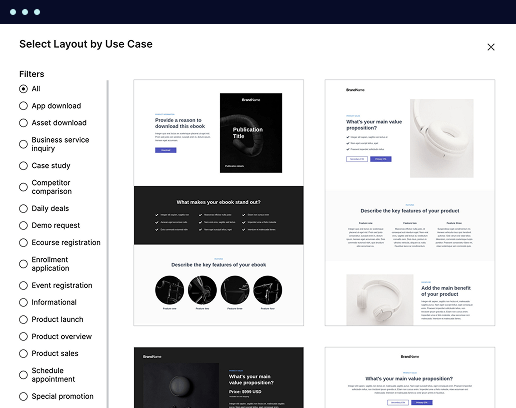
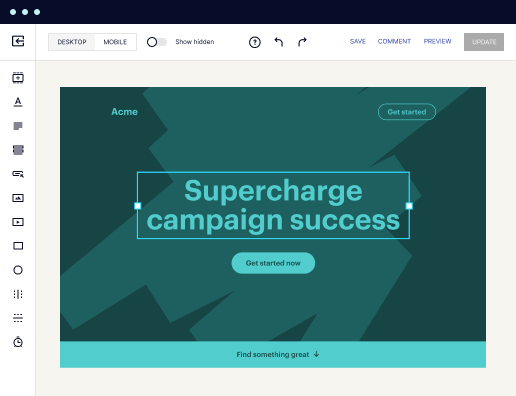
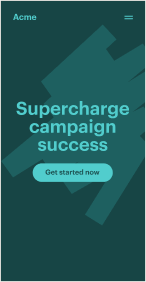
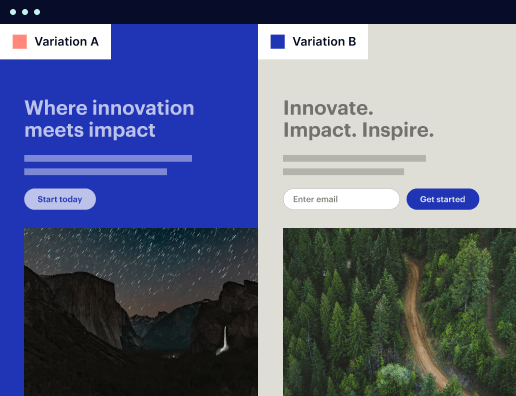

Easy to build without coding
With the intuitive drag-and-drop builder, anyone on your team can create high-converting pages without any knowledge of code or design. Make enhancements to your landing page with custom widgets using Javascript, HTML/CSS, or third-party scripts.
Multiple layouts for any industry and goal
Select from 500+ landing page layouts built to boost conversions across industry-specific scenarios. Customize them by adjusting fonts, adding images, and generating on-brand content with the AI assistant. Quickly scale with Instablocks® and Global Blocks that you can save, reuse, and update globally.
Loads fast and looks polished on any device
Every template is responsive, which means they present professionally on any device and load blazingly fast with our Thor Render Engine.
Robust analytics & experimentation
Get real-time updates and reporting across all your devices, showing the number of visitors, conversions, cost-per-visitor, and cost-per-lead. Launch AI-powered experiments, run A/B tests, and use heatmaps to analyze user behavior, then optimize your landing page to maximize conversions.
All the features you need to build lead-generating landing pages
Explore more featuresLearn how to build top-performing landing pages for any goal
FAQs
Leading the way in building high-performing landing pages





A comprehensive guide to using Instapage for optimized landing pages and CRO
Creating high-converting landing pages is crucial for maximizing ROI in your digital marketing campaigns. Instapage provides an unparalleled platform that enables marketers in various industries—including business services, tech, and education—to effortlessly design landing pages that capture leads and drive conversions.
Understanding the Instapage platform
Instapage is an all-in-one solution that offers powerful tools for creating effective landing pages. It empowers users to leverage over 100 high-converting templates and pre-built lead generation elements. This is particularly beneficial for marketers who are looking for quick deployment without needing extensive technical skills.
- Wide variety of templates: Choose from over 100 customizable options tailored to different business needs.
- User-friendly interface: Build pages easily using drag-and-drop functionality, which minimizes the need for coding.
- Lead generation features: Integrated forms and CTAs help capture visitor information effectively.
Step 1: Building your first landing page
To create a landing page, begin by selecting a template that aligns with your campaign goals. Instapage’s interface allows marketers to tailor each element to fit their specific audience.
- Select a template that matches your campaign's objectives.
- Customize the elements using Instablocks for flexibility in layout and design.
- Incorporate relevant images and copy that resonate with your target audience.
Step 2: Optimize for conversions
Optimization is key to ensuring that your landing pages perform at their best. Use Instapage’s experimentation features to make data-driven decisions on design and content.
- Utilize heatmaps to analyze visitor behavior and identify areas for improvement.
- Conduct A/B testing to compare different versions of your page.
- Leverage analytics dashboards to monitor performance and make informed adjustments.
Step 3: Personalizing user experience
Dynamic text replacement and audience segmentation are invaluable tools for personalizing your landing pages. Instapage allows you to customize content based on user demographics and behavior, which significantly enhances engagement.
- Implement dynamic text replacement to align your message with specific visitor queries.
- Use AdMaps to ensure that the ads drive users to the right pages.
- Track audience-specific metrics to gauge the effectiveness of your personalized content.
By following these steps, marketers can leverage Instapage to create high-performance landing pages that drive conversions.
Ready to maximize your digital campaigns? Start using Instapage today and watch your ROI soar!
People also ask about HTML/CSS optimized conversion focused page template
HTML/CSS optimized conversion-focused page template
The foundation of conversion-focused design
Creating a conversion-focused landing page is built on understanding what drives visitors to complete desired actions. These pages are specifically designed to lead users toward a goal, such as signing up for a newsletter, purchasing a product, or filling out a contact form. The clarity of purpose in these pages lays the groundwork for maximizing conversion rates.
Design plays a pivotal role in conversion psychology. The way information is presented can heavily influence user decisions. Engaging layouts that capture attention and lead users effortlessly through the content are essential. A well-thought-out design minimizes distractions and reinforces the message, making it clear what the user should do next.
Definition of conversion-focused landing pages
The psychology of conversion: Why design matters
Key elements of an effective page template
For a landing page template to be effective, it must incorporate several key elements. A strong headline grabs attention immediately and allows visitors to understand the value proposition quickly. Supporting subheadlines provide further context, enticing users to continue reading. Engaging visuals, whether images or videos, enrich the user experience, conveying messages in a way that text alone often cannot achieve.
Furthermore, the call to action (CTA) is a vital element; it must be clear, concise, and compelling. A strategically designed layout is crucial to directing attention towards these key components in a hierarchical manner, ensuring that the user’s journey through the page is logical and intuitive.
Exploring HTML/CSS for optimization
Crafting lightweight, fast-loading templates is integral to user retention and conversion. Studies show that users are likely to abandon a page that takes more than a few seconds to load. Therefore, reducing the amount of code, optimizing images, and minimizing CSS and HTML files are vital strategies in optimizing performance.
Best practices for HTML and CSS optimization include utilizing web fonts selectively, employing CSS Grid or Flexbox for responsive layouts, and reducing dependencies on heavy libraries. Compressing images and leveraging browser caching can contribute significantly to improved site speed.
Importance of page speed in conversion rates
Best practices for HTML and CSS optimization
Responsive design principles
Considering the overwhelming use of mobile devices to access websites, responsive design has become imperative. A mobile-friendly template ensures usability across various screen sizes. Using media queries to create adaptable layouts enables seamless transitions from desktops to smartphones, enhancing user experience and increasing the likelihood of conversions.
Techniques such as fluid grid layouts maintain proportions across different devices, while flexible images adjust based on the viewport size. Testing templates on various devices before launch can help ensure responsiveness is achieved. This responsiveness is not just a checkbox feature; it significantly affects how users interact with content and their overall satisfaction.
Harnessing the power of a drag-and-drop builder
User experience can greatly benefit from drag-and-drop functionality in web design. This intuitive design approach simplifies the process for individuals without coding experience, enabling them to build professional-looking pages efficiently. A user can drag elements into place and customize the template in real time, eliminating the need for extensive technical skills.
Real-time customization facilitates immediate visual feedback, allowing users to see how their changes affect the overall layout and user flow. This instantaneous feedback loop is invaluable, as it helps in quickly identifying design problems and encourages more iterations leading to an optimized final product.
Simplifying the design process for non-coders
Real-time customization: Immediate visual feedback
Customization options within the builder
The ability to integrate multimedia elements such as images, videos, and infographics plays a significant role in enhancing engagement. Customizable themes help marketers align their pages with specific audience expectations, enhancing brand identity. With drag-and-drop builders, adjusting styles—such as fonts, colors, and layouts—becomes seamless. This flexibility allows marketers to experiment with different designs without fearing significant downtime or resource investment.
Moreover, integrating personalized elements can help cater specifically to target demographics. This ability to modify templates allows for tailored marketing strategies that resonate with users, making for a more engaging and relevant experience.
The role of templates in accelerating production
Pre-built templates are essential in saving time and effort during the landing page creation process. Tailored specifically for various industries, from e-commerce to SaaS models, these templates include just the necessary features to meet the unique goals of each sector. Templates eliminate the guesswork involved in designing pages from scratch and allow marketers to quickly launch campaigns.
Furthermore, templates help maintain a consistent brand identity across multiple campaigns. Creating cohesive experiences fosters trust and recognition among consumers, which is vital for conversion rates. Updating these templates with new content or visuals is uncomplicated, ensuring brand elements are preserved as marketing strategies evolve.
Industry-specific stages: E-commerce, SaaS, and nonprofits
Importance of relevance: Templates crafted for certain business types
Utilizing templates to foster consistency and brand identity
A cohesive brand experience significantly influences consumer decision-making. A template library enables marketers to implement design elements that are already aligned with brand guidelines, fostering familiarity with customers. The ability to quickly adapt existing templates for new campaigns allows for speedier market responses while sustaining brand cohesion.
Consistently updated templates contribute to the overarching brand narrative, ensuring that marketing messages remain relevant. Templates serve as a framework within which marketers can innovate without dissipating brand identity.
The integration of popups and other engagement bars
Popups and engagement bars can play crucial roles in boosting conversion rates by effectively capturing leads. These elements create additional opportunities for interaction, turning visitors into valuable contacts. Popups can prompt users to input their email addresses for services or offer exclusive discounts, significantly increasing the chances of conversions.
Examples of high-converting popup designs include those that are time-sensitive or contextually relevant to the user’s journey. Elements such as urgency—through limited-time offers—can mobilize users quickly. Strategically placed engagement bars, especially those that relate to users' browsing history, can command attention without overwhelming the user experience.
Gathering leads: Capturing visitor information effectively
Examples of high-converting popup designs
Strategies for effective use of engagement bars
When deploying popups or engagement bars, strategic timing and user behavior triggers are critical. Analyzing visitor patterns can provide insights on the perfect moments to engage users. Whether this means waiting until users have scrolled a certain percentage down the page or triggering a popup when a user is about to exit, determining the right moment can significantly improve engagement rates.
A/B testing is another vital component to discover what styles of popups and engagement bars achieve the best results. Running simultaneous variations allows marketers to analyze which designs resonate best with users while continuously refining their approach based on data.
The canvas: Visualizing transformation
The design canvas is a powerful tool that aids in visualizing landing pages. It provides a single space where various elements can be arranged, tested, and modified. Having a central design area ensures that every component is well-positioned to guide users naturally toward the intended conversion action, amplifying user engagement.
Balancing aesthetics with functionality is crucial when utilizing the canvas. Elements should not only please the eye but must also adhere to usability principles. Each design choice on the canvas should contribute to enhancing the user journey, utilizing whitespace effectively to reduce clutter and direct focus.
Overview of the design canvas utility and features
Elements of design: Balancing aesthetics and functionality
Tips for efficiently utilizing the canvas for layout and flow
To maximize visibility and engagement within the design canvas, it is essential to arrange elements logically. Consider employing grid systems to keep content structured, allowing users to navigate intuitively through the page. Flow should be guided by visual storytelling; using visual hierarchies can create a narrative that naturally leads users from one section to the next.
Creating a compelling visual journey keeps users engaged and primes them for action. Utilizing contrasting colors can also help important elements stand out, ensuring they attract the right attention at the right time.
Tools for continuous testing and optimization
Incorporating analytics into landing page design is vital for improving performance. Setting up tracking mechanisms provides insights into user behavior, allowing marketers to understand how visitors interact with their pages. Analyzing this data drives informed design revisions, enabling continuous improvements on the user journey.
Quantitative data offers a foundation, but qualitative feedback loops enrich insights. This iterative design process fosters enhancements that cater to actual user preferences, ultimately driving conversion optimization. Marketers must always focus on ensuring that objectives align with analytics to truly harness this power.
Setting up tracking to understand user behavior
Leveraging data to inform design revisions
Conversion rate optimization with iterative design
Implementing A/B testing enables marketers to measure the success of different design elements rigorously. This process involves comparing variations to see which format yields the most conversions. Conducting effective A/B tests requires clear goals to ensure that adjustments are not just changes, but strategic improvements aimed at addressing specific user needs.
The iterative approach is invaluable, allowing quick pivots based on feedback and metrics. Continuous learning from these tests positions marketers to adapt swiftly to evolving trends in user behavior, ensuring they remain competitive.
Best practices: Maximizing conversion with design principles
Crafting compelling calls to action (CTAs) is critical in conversion-focused design. High-performing CTAs share common characteristics; they are clear, actionable, and instill a sense of urgency. Employing strong action verbs can encourage users to engage and often pushes them to complete the desired action.
Strategic placement of CTAs enhances visibility. It’s beneficial to position them at key points where users logically decide to take action, such as after informative sections or enticing visuals. Testing various placements helps identify optimal locations that yield higher interaction rates.
Characteristics of high-performing CTAs
Placement strategies: Positioning for maximum visibility
Using color psychology to influence visitor behavior
Color choice can influence visitor behavior significantly. Different colors evoke different emotions; using this knowledge can guide purchasing decisions. For instance, reds often create a sense of urgency, while blues are associated with trust and reliability. Creating a palette that aligns with brand identity while strategically leveraging color psychology can enhance overall impact.
Implementing contrasting colors for CTAs makes them stand out, drawing attention right where it’s needed. The combined effect of well-placed CTAs and strategic color choices can create a powerful push toward conversion.
Future-proofing your landing pages
Preparing for upcoming trends in page design is essential for marketers committed to maximizing conversions. User preferences are constantly evolving; it's critical to adapt landing pages accordingly. Understanding trends in minimalism, dark modes, and user-centric designs can provide insights into how to stay relevant.
Emerging technologies such as AI-driven personalization and augmented reality can also impact how landing pages are designed and function. Familiarity with these advancements and their potential applications will position marketers to innovate effectively and keep up with changing user expectations.
The evolution of landing pages in response to user needs
Emerging technologies and their potential impact on conversion rates
Continuous learning: Staying ahead in HTML/CSS optimization
Engaging with educational resources and community platforms dedicated to HTML and CSS optimization is crucial for ongoing growth. No matter how proficient a marketer becomes, there's always room to deepen knowledge and discover new tricks for enhancing landing pages.
Following industry leaders and participating in forums fosters a culture of continuous innovation. Emphasizing a mindset of adaptability guarantees that marketers can respond favorably to shifts in the digital landscape.
Case studies: Real-world applications and success stories
Analyzing high-performing pages built with optimized templates provides invaluable insights into effective design. Case studies that showcase exceptional conversion rates allow marketers to dissect what works and replicate success in their campaigns.
Lessons from successful landing page campaigns reveal common threads such as clarity of message, strategic CTAs, and relevant visuals. These elements, when combined, lead to powerful results, serving as a roadmap for marketers looking to improve their own landing pages.
Breakdown of case studies showcasing exceptional conversion rates
Lessons learned from successful landing page campaigns
Lessons from industries that excel in conversion-focused design
Industries such as e-commerce, tech, and education have demonstrated the effectiveness of optimized landing page designs. Analyzing their strategies reveals how tailored approaches resonate with target audiences, emphasizing the importance of understanding specific needs and preferences.
Deep dives into successful implementations highlight the significance of data-driven design principles and custom templates crafted to engage users. Through these lenses, marketers can better recognize the value of industry-specific insights to enhance their own landing pages.
Ready to skyrocket conversions?
Supercharge your ad campaigns with high-performing landing pages
Get started